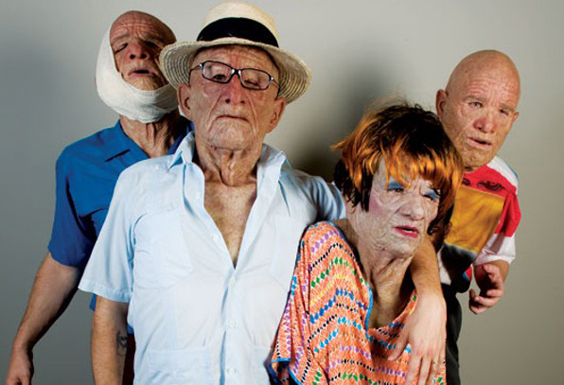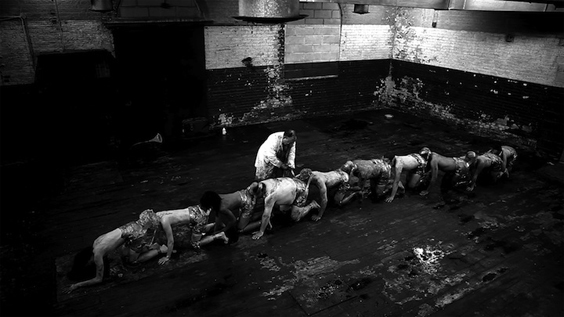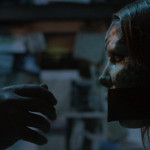A STOMACH-CHURNING TALENT
FX whiz Dan Martin talks ABCs OF DEATH 2, TRASH HUMPERS and Fantastic Fest short film THE STOMACH
On any given year, scanning through hundreds of shorts in the process of programming will see certain regions or countries emerge as more prolific than others; this year it was the UK that cialis online doctor gave me the most grief when it came to trimming down the Fantastic Fest program to a powerful but tiny selection of what the past year had to offer. There were so many astounding films that many simply couldn’t make it in due to space – I must mention Dan Auty’s APHELION POINT, Jo Lewis’ LADY LUCK and Lee Cronin’s GHOST TRAIN as a few that will haunt me – but of those UK shorts that will see a premiere at this year’s Fantastic Fest, Ben Steiner’s THE STOMACH get levitra over night delivery is something special.
THE STOMACH is about a sickly spirit guide who has a rather unusual means of communicating with the dead. Without giving too much away about the plot, it can be said that when the film called for the titular organ – a protruding, bloated, gurgling thing – there was one man to call: Dan Martin.
After starting out with apprenticeships on BATMAN BEGINS and THE WOLFMAN, Martin has become a busy man in the UK indie scene, with credits ranging from Sean Hogan’s THE DEVIL’S BUSINESS to Ben Wheatley’s A FIELD IN ENGLAND (he’s also working on Wheatley’s upcoming adaptation of JG Ballard’s HIGH RISE, which it was too early to get into here). But his strangest gig may have been his uncredited role as camera advisor on Harmony Korine’s TRASH HUMPERS, for which he constructed a rather ingenius means of making the film appear shot on VHS (contrary to rumour, it wasn’t).
Martin’s work lights up the screen in two films playing this year’s Fantastic Fest: THE STOMACH and the highly anticipated anthology sequel ABCs OF DEATH 2, for which he worked on several of the film’s UK-based segments. The latter has its World Premiere at Fantastic Fest on September 18th and will be live-streaming to multiple Alamo Drafthouse locations around the country (details HERE) and THE STOMACH has its US Premiere on Sunday as part of the Short Fuse program (details HERE). Dan lowest cost levitra no prescription canada took a few moments to be grilled about his various FX work in anticipation of these Fantastic fest screenings.
——————
Kier-La Janisse: What is your own background and how did you get into working on special FX?
Dan Martin: Ha ha, this is a popular question, although it’s normally phrased “how can *I* get into special FX”. It’s hard to pinpoint the moment when it went from being a fantasy and started to be something I was actually doing. I wanted to get into cialis generic drug it from childhood, ever since I knew it was a real job, you know, something you could actually do. As a kid I loved magic, then, at around nine years old, I discovered horror movies and the concept of special effects. I saw one as a visceral version of the other and was transfixed. Once I knew what I wanted to do it was a mix of hunger for knowledge, obsession, luck and tenacity. I can’t stress enough how much being able to talk to people is essential. It doesn’t matter if you’re an incredible artist if you can’t get out there and start a conversation, if you can’t show people.
KJ: You seem to work both on features as well as indie shorts, is that a conscious decision to keep one foot in the shorts world?
DM: Not conscious, no. I mean, a short is much lower commitment than a feature, so it’s a good way of knowing if I want to work with a new director. I’ve been lucky to have been brought some really great stuff. I did shorts with Ben Wheatley and Johannes Roberts before we did SIGHTSEERS or F; it’s a nice way to find out how you work together.
KJ: For Ben Wheatley’s A FIELD IN ENGLAND you’re credited as prosthetic FX.
DM: Yes, we made the two head shots, the impaling, the fake penises, a bunch of musket hits and Michael Smiley’s splitting leg. We also made some of the custom props, such as the broken pike that is carried throughout the film and the crystals that Reece Shearsmith vomits up. Ben still refers to the final head shot gag as the gobstopper head because in the FX shot, just after he edits out in the film, one of the eyeballs dropped down into the void of the head and rolled out the mouth. We all pissed ourselves laughing behind the monitor.
KJ: Can you tell me a bit about the actual process of conceiving of and constructing the titular stomach in Ben Steiner’s film THE STOMACH?
DM: I don’t want to spoil anything, but there are actually three stomachs in the film, referred to imaginatively as stomachs one, two and three. Each depicts a different level of bloat/haunting and the story required a lot of back and forth. We realized early on that the schedule wouldn’t allow us to order shoot by stomach state and the time required for a blended application rendered that an impractical option. Producer Dan Dixon works in post FX by day so we had access to some great VFX so we decided I should design a series of quick-change, drop-on prosthetics so we could swap back and forth as needed. The edges were never going to be neat enough to not-need digital clean up but each included plastic space fillers and multiple air-fed bladders that gave the silicone skins their movement. The design was based on the idea that this had been happening since childhood so the ribs were distorted and the skin stretched and distended, so even the “empty” stomach was a prosthetic.
KJ: Another Fantastic Fest premiere you’re involved with is ABCs of DEATH 2 – what director were you working with, and how did the extremely miniscule budget of those segments affect your approach to the FX?
DM: I actually did 4 chapters: B, directed by Julian Barrett and G, directed by Jim Hoskings. Both of these were produced by Andy Starke (of Rook Films, producer of SIGHTSEERS, AFIE, KILL LIST etc and Fantastic Fest regular). C, Directed by Julian Gilbey (Director of A LONELY PLACE TO DIE and PLASTIC) and Y, directed by Juan Martínez Moreno (Director of the criminally underseen GAME OF WEREWOLVES). These segments have always been a fun challenge. It’s the how-do-we-do-it bit of my job I enjoy the most, so a good script, even if it doesn’t have the biggest budget, will get my full attention as long as it poses me a problem I want to solve.
KJ: What is the main way short films gather their crews in the UK? Is there some kind of portal or platform that short filmmakers consult to make announcements or check out who is available to work?
DM: There’s a few places – Shooting People, Mandy, etc, but the indie scene in the UK is pretty close knit so there’s a lot of word of mouth. It’s mostly who you know/got drunk with at a recent wrap party.
KJ: Tell me about working on Harmony Korine’s TRASH HUMPERS. How did that come about?
DM: That was an experience. I knew the fantastic Leo Scott, who was editing for him and was introduced not as an effects artist but as a camera advisor. Harmony was very keen, early on, to harness the aesthetic of 80’s home movies and Leo mentioned that I collect old cameras. Leo and I ended up shooting him walking his dog Bishop from my garden into my house about twenty times on different analogue and digital cameras. Old VHS machines, BETA, Hi8, etc. I then copied the shots back and forth on two old Sony SLV E920 VHS edit machines and the result kind of became Harmony’s look-book.
KJ: You mentioned once that you had constructed some kind of special camera for the film to make it look shot on VHS, but I am fuzzy on the details.
DM: It quickly became obvious that we couldn’t actually shoot on VHS so I took apart and rebuilt three Flip cams and put lens mounts on them. My friend Richard Fosh built me a steadcam and a shotgun mount for them and we shot on those. Then, using the VHS machines we would “de-grade” (pun intended) the footage on a scene-by-scene basis. I also got an incredible glitch-core artist called Karl Klomp to build us some analogue data smashing machines, so when we were re-digitizing the footage we could manually destroy the tracking etc. My effects work was almost an afterthought. I stayed in the same room as Leo in Nashville and just built things as Harmony needed/thought-of them. It was my first time working with him and I wasn’t ready for how low his shoot-to-use scene ratio was. A lot of stuff we shot was left out in the end, including a scene where the Humpers steal a baby (played by Harmony’s infant daughter) and cook her in an oven. I made an anatomically accurate baby puppet that was gutted on camera and eaten. Ha ha. I remember taking that through customs in hand luggage…
KJ: You are credited as on-set FX supervisor for HUMAN CENTIPEDE TWO – what did that entail?
DM: That was a fun one. Tom and Ilona Six had contacted John Schoonraad to take care of the effects and he had already built some of the stuff for the movie before his work commitments meant he asked me to come in and take over. I came in about a week before the shoot started (bringing a student of mine, Dan Gomer, with me) and made a bunch of stuff, the teeth smashing rig, the knee cutting rig, the smashable and post-smash heads, among others. John had already done all the life casts (that’s where he started, he’s widely regarded as one of the best life casters in the country) and made the fake bums the actors wore to stop them actually being ass to mouth. Then, location ended up being coincidentally round the corner from my workshop in south London so I was suggesting and building things on the fly throughout the shoot (like the pneumatic shit cannon, the force-feed rig, etc). I basically took it as a personal challenge to gross Tom out while he was looking at the monitor. We managed eventually.
KJ: There’s been quite a renaissance in British indie horror over the last decade – as someone who works alongside shorts directors frequently, who do you think the next British director – or writer – is who will burst out the short film scene to be hailed as a major talent?
DM: Nick Gillespie (Ben Wheatley’s 2nd unit director) will be directing his first feature in 2015, that’s a great script. Also, Mark Blackman, with whom I did the short Skin, is prepping for another short early next year and then his first feature. Both are names worth keeping an eye on.
*****

 September 18, 2014
September 18, 2014  No Comments
No Comments









